Italy is often described as an open-air museum, with archeological marvels and hidden gems around every corner. However, it’s safe to say that visitors often have specific artworks and sites in mind when they arrive. After all, as long as they have existed, certain Italian artworks have earned their heralded spot on tourists’ bucket lists. Sandro Botticelli’s Birth of Venus, Michelangelo’s David, and Artemisia Gentileschi’s Judith Beheading Holofernes are just a few that many have cited as “must-see” before they die.
However, Italy boasts a wealth of artistic treasures beyond its renowned masterpieces. As a classical historian, I’ve studied Italian art for over a decade and have come across so many spectacular, yet overlooked, works of art to see in the country. I guarantee these pieces will surprise you and add zest to your trip between the classic, famous stops. And you may even avoid some of the crowds, which is always a plus!
Here’s my list of 10 Italian artworks you’ve probably never heard of. Which one is your favorite?
1. La Fornarina by Raphael, Rome
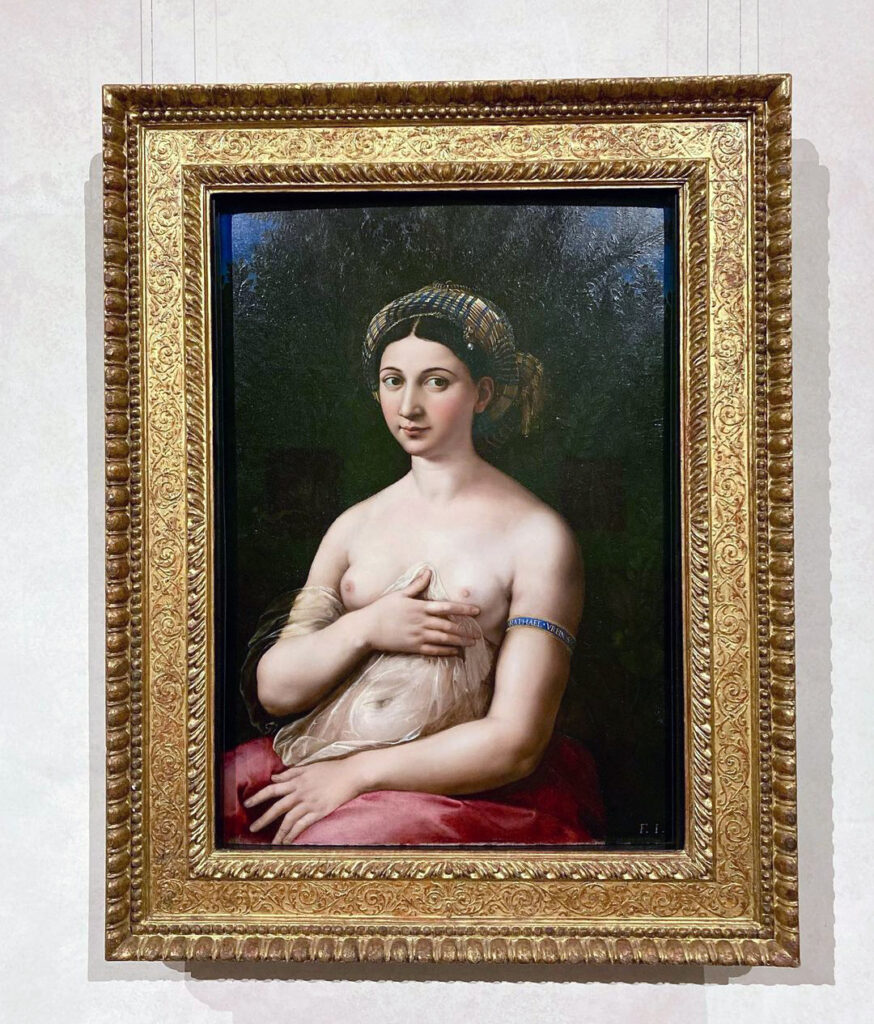
La Fornarina (“The Baker’s Daughter”), a painting by the great Renaissance master Raphael Sanzio, is located in Palazzo Barberini. One of Rome’s great museums. It depicts a beautiful semi-nude young woman wearing a thin veil over her belly and chest, held up by her hand covering her left breast. She wears a bright blue and yellow turban over her dark hair and a red cloth over her legs. On her left arm, she wears an armband engraved with the painter’s signature, “Raphael Vrbinas,” or Raphael of Urbino.
Historically, the woman in the portrait is known as Margherita Luti. She was the daughter of a Sienese baker and the artist’s legendary lover. Margherita was believed to be Raphael’s muse and appeared in several paintings, though she refused to marry the artist. Raphael was so distracted by his infatuation, that Margherita was bribed to leave Rome so he could once again focus on his art. This juicy love story has been recounted in biographies of Raphael since the 16th century! Many blamed Margherita for Raphael’s death, connecting his demise to “too much lovemaking.” Yikes.
You can find Margherita’s home in Trastevere on the corner of Via Dorotea and Via di Porta Settimiana. Its characteristic window is richly decorated and framed by a pointed arch.
2. The Riace Warriors, Reggio Calabria

Dynamic, lifelike, and incredibly powerful, the Riace Warriors is the next artistic destination on our list. This pair of life-sized Greek bronze statues of young, nude, bearded warriors were discovered in 1972 in Calabria off the coast of Riace Marina. In the ancient world, nudity was a sign of heroism or divinity. Originally positioned to hold shields and spears (now missing along with their helmets), the pair were created with a mix of materials. The eyes are white calcite, with glass paste for the iris and pink stone for the teardrop. The lips, eyelashes, and nipples are made of copper, while the teeth are made of silver paper.
While bronze statues may not be at the top of everyone’s must-see list, the Riace Warriors are stunning examples of early Classical art. Not to mention a result of one of the most important archaeological finds of the 20th century. They are currently located in the Museo Nazionale della Magna Grecia in the city of Reggio Calabria. Although their dating and significance are still being debated by scholars, it is generally agreed that the statues were created during the 5th century BCE. They are also thought to be part of a much larger sculptural group.
3. Chiesa Rossa Light Installation by Dan Flavin, Milan
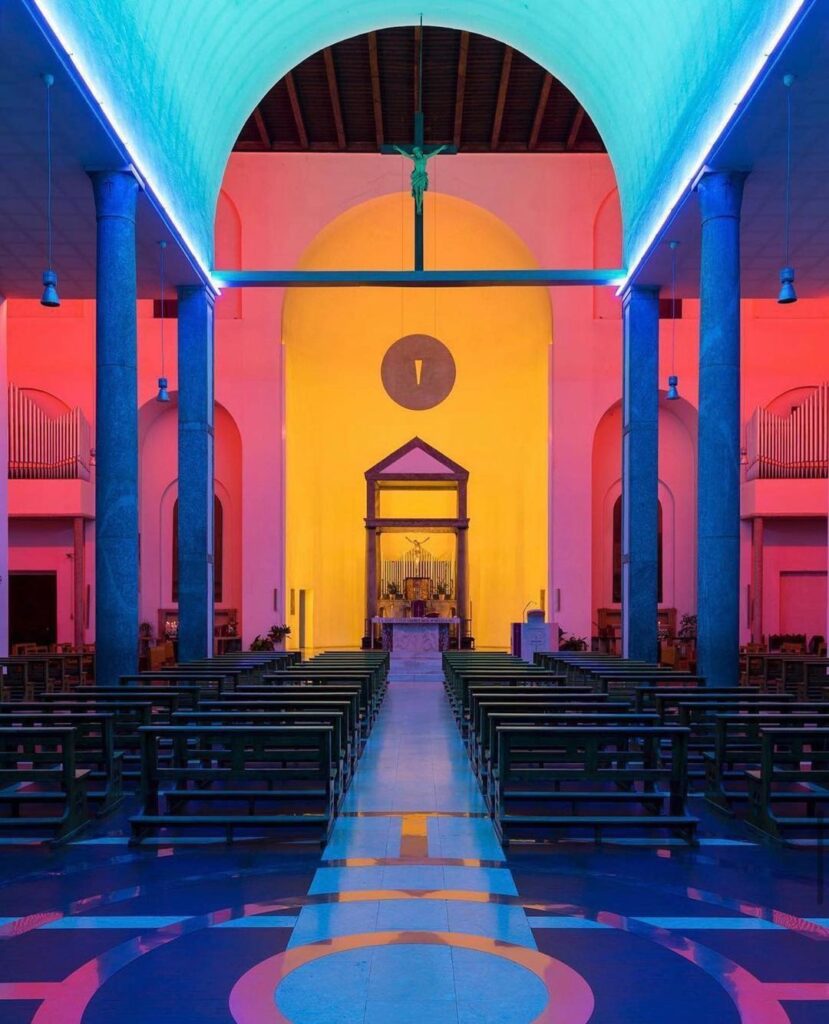
I tend to be picky when it comes to modern and contemporary art but this colorful light installation is a must-see for any art lover! In 1996, American artist Dan Flavin was invited by Italian priest Giulio Greco to create an artwork for the restoration of the church of Santa Maria Annunciata in Chiesa Rossa in Milan. The site-specific installation focuses on Flavin’s exploration of light and its interaction with color, space, and material.
The entire space is illuminated in blocks of different colors. Brilliant green, blue, pink, and gold ultraviolet lights, highlight the interior architecture of the church. The result is a breathtaking, spiritual environment that mimics the progression of light throughout the day. As you walk down the nave from the entrance to the transept, you step from night to dawn until you reach the apse, which is illuminated in brilliant yellow representing daytime. Santa Maria Annunciata in Chiesa Rossa is located on Via Neera 24 in Milan. The installation is open daily from 4:00-7:00 pm.
4. Ceiling Fresco, Sala del Mappamondo, Villa Farnese, Caprarola
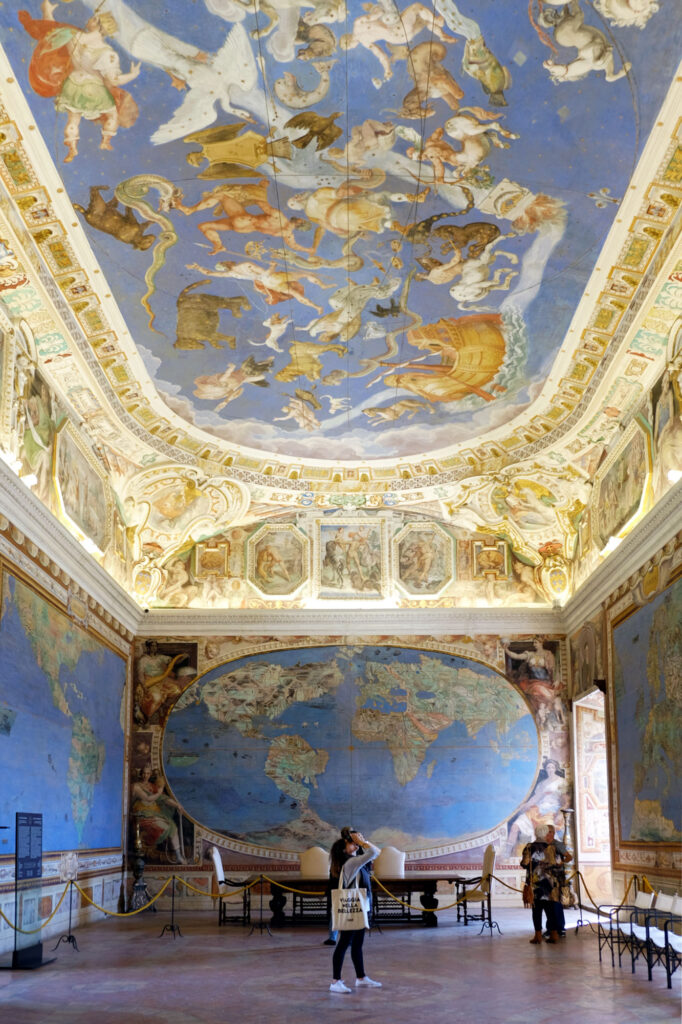
Two hours north of Rome, Villa Farnese is an extraordinary pentagonal-shaped Renaissance villa located in Caprarola. It was commissioned by Cardinal Alessandro Farnese who was appointed a cardinal by his grandfather Pope Paul III. This 16th-century villa boasts a breathtaking spiral staircase adorned with intricate frescoes and a courtyard encircled by colonnades. But one room in particular took my breath away.
Among Villa Farnese’s many wonders, the Sala del Mappamondo (“Map Room”) is a standout. Adorned with monumental maps of the world and a ceiling depicting vibrant constellations, this room is a sensory feast. The 12 signs of the Zodiac, and other constellations and celestial legends, seem to dance against a field of brilliant blue. I definitely got a crick in my neck after looking up for so long. I suggest taking your time in this room as it is jam-packed with detail.
The surrounding property and lavish gardens alone are as impressive as the building itself. The “casino” — a small summerhouse in the garden — served as the setting for the Capulet’s home and Juliet’s balcony in Julian Fellow’s version of Romeo and Juliet. While you’re in the area, don’t miss the chance to visit nearby Villa Lante in Bagnaia and Castello Ruspoli in Vignanello. The entire Tuscia region is well worth a trip from Rome! It makes for a perfect long weekend filled with cultural and beautiful scenery.
5. The Hunt for Diana, Domenichino, Rome
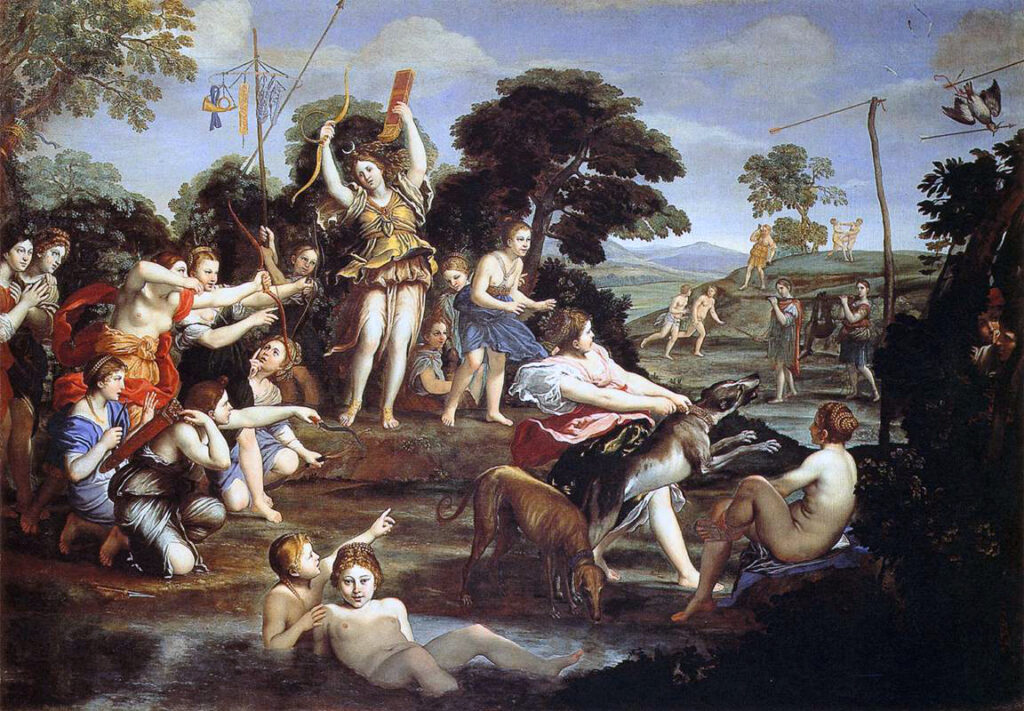
Located in Galleria Borghese, it’s safe to say that this painting has quite a bit of competition. Given its proximity to Gian Lorenzo Bernini’s spectacular sculptures and Caravaggio’s paintings, it’s no wonder it is often overlooked. However, The Hunt for Diana — with its colors, imposing size, and theme of feminine strength and freedom — is a masterpiece. One with an intriguing story behind it.
Created by the Baroque artist Domenichino in 1616, the painting led to the artist’s unlikely imprisonment. The seven-by-ten-foot-tall canvas was commissioned by Cardinal Pietro Aldobrandini for his villa in Frascati. It depicts the goddess Diana and her huntresses and nymphs, locked in a series of competitions across the beautiful landscape of the Tusculan hills. Two men are hidden in a bush on the right-hand side of the scene, facing two greyhounds getting ready to rip them to shreds.
So how did the work end up in Galleria Borghese in Rome? Cardinal Scipione Borghese loved the painting so much that he asked the painter to give it to him instead. Domenichino, understandably, said no, given that it was commissioned by Aldobrandini. Borghese then did what any logical person would do in this situation. He ordered the painting to be stolen from the artist’s home and imprisoned Domenichino for several days! The artist was forced to give in and eventually relinquished the canvas to Borghese.
6. Hall of Mirrors, Galleria Doria Pamphilj, Rome
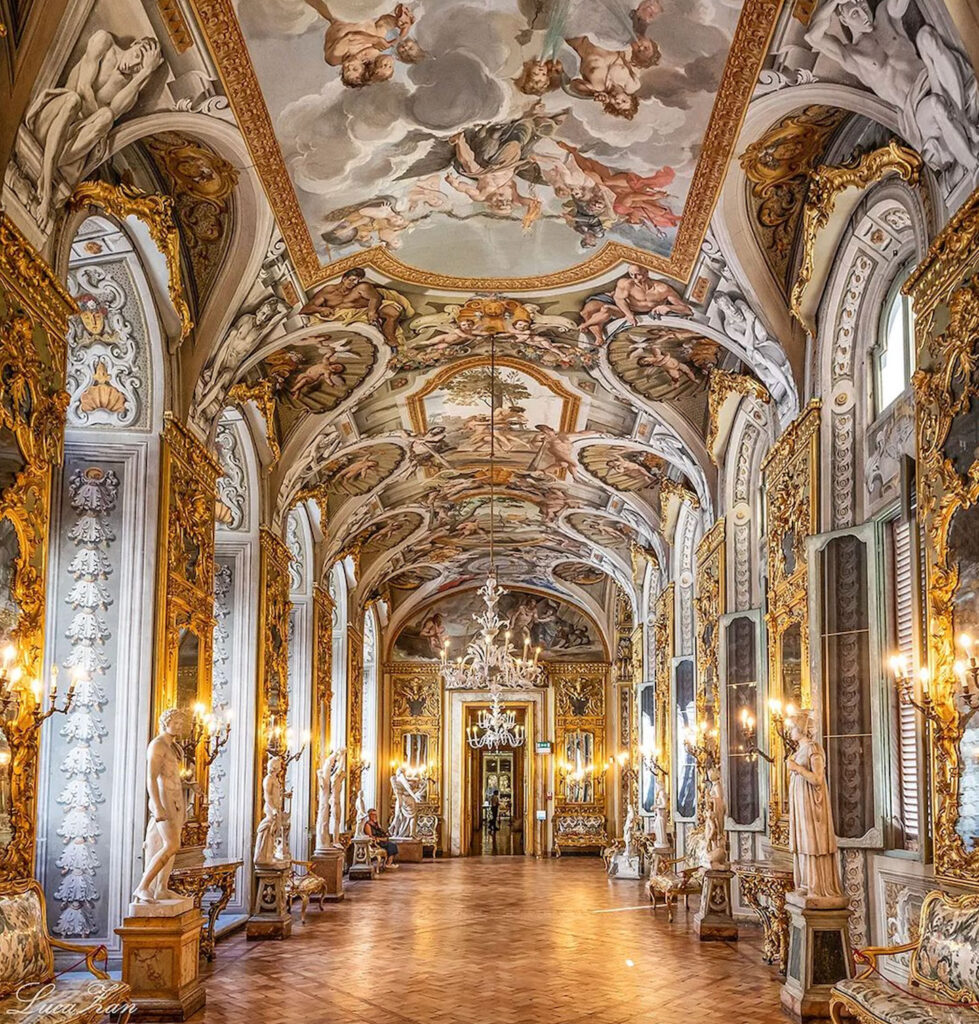
The next stop on our list is not one work of art but an entire museum! Galleria Doria Pamphilj, an opulent palazzo in the middle of Via del Corso, is the result of 500 years of renovations and additions! The museum may look small on the outside, but the museum extends across 11 rooms, each marked by different themes and artistic styles.
Once the home of the prominent Doria Pamphilj family, this museum is a love letter to art history. There are so many works of art inside that cover the walls from top to bottom; from Renaissance landscapes and Flemish seascapes to Baroque sculptures and classical ceiling frescoes. The museum is also home to some beautiful Caravaggio paintings. These include The Penitent Magdalene and The Rest on the Flight to Egypt. (Looking for more Caravaggio? Here’s where to see his works in Rome).
One of the best surprises in this gallery is its Hall of Mirrors. This glittering hallway alternates tall gold-framed Venetian mirrors and archaeological sculptures creating a mini-Versailles in the middle of Rome. Above, the ceiling depicts the “Twelve Labors of Hercules” in connection to the Doria Pamphilj family tree, painted by the Bolognese artist Aureliano Milani between 1731 and 1734.
7. The Burial of St. Petronilla by Guercino, Rome

One of the most awe-inspiring, and underappreciated, gems in Rome is The Burial of St. Petronilla by the Bolognese artist, Guercino. Located in the Capitoline Museum in Rome, this incredible arch-shaped painting stands a whopping 24 feet tall! Let me tell you that seeing this painting in person is an experience. Although it’s located towards the back of the hall surrounded by other artworks, your eye will instantly be drawn to it. Your jaw is sure to drop when you enter the room.
This brilliant oil painting simultaneously depicts Saint Petronilla’s burial and ascent into heaven. At the top, wearing richly decorated robes and delicate flowers in her hair, Petronilla is being welcomed into heaven, kneeling before Christ. Towards the bottom, she is being gently lowered into her grave by gravediggers. Petronilla was an early Christian martyr and is known as the patroness of fevers and the dauphins of France. Although it sounds arbitrary, part of her connection to the French crown comes from the dolphin (dauphin in French) that was reputedly found carved on her sarcophagus!
The painting was originally commissioned for an altar in St. Peter’s Basilica. However, it was taken to the Louvre in Paris by Napoleon’s troops. It was eventually brought back to Italy by none other than the artist Antonio Canova. The painting was then transferred to Palazzo del Quiriniale in Rome before being placed in the Capitoline Museums in 1815.
8. The Portonaccio Sarcophagus, Rome
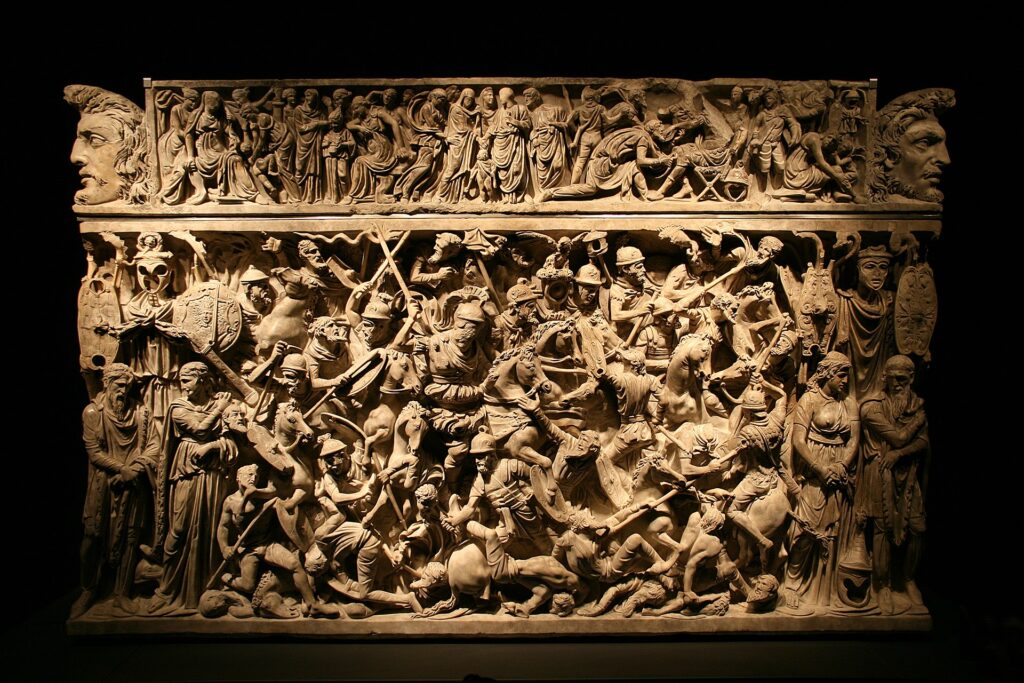
A sarcophagus may seem like an unlikely work of art, but this one is a personal favorite. It stopped me dead in my tracks when I was visiting Palazzo Massimo alle Terme in Rome. This museum holds some of the most important works of ancient art in Rome and is worth a visit.
The first thing you notice is the incredible detail and size of this ancient funerary monument. Created during the 2nd century CE, the Portonaccio Sarcophagus measures almost four feet tall and seven feet wide. It depicts the frenzied battle between Marcus Aurelius’ cavalry and the Germans. The sarcophagus inscription suggests that it was made for a general named Aulo Giulio Pompilio Tito Vivio Levillo Pisone Bereniciano.
The intense and savage battle is vividly sculpted in high relief on the front panel of the Sarcophagus. If you look closely, you’ll see galloping horses, swords, and shields raised, and Romans twisting and turning while they fight the opposing army. The scene makes any Hollywood rendition seem tame by comparison.
9. Portrait of the Four Tetrarchs, St. Marks Basilica, Venice
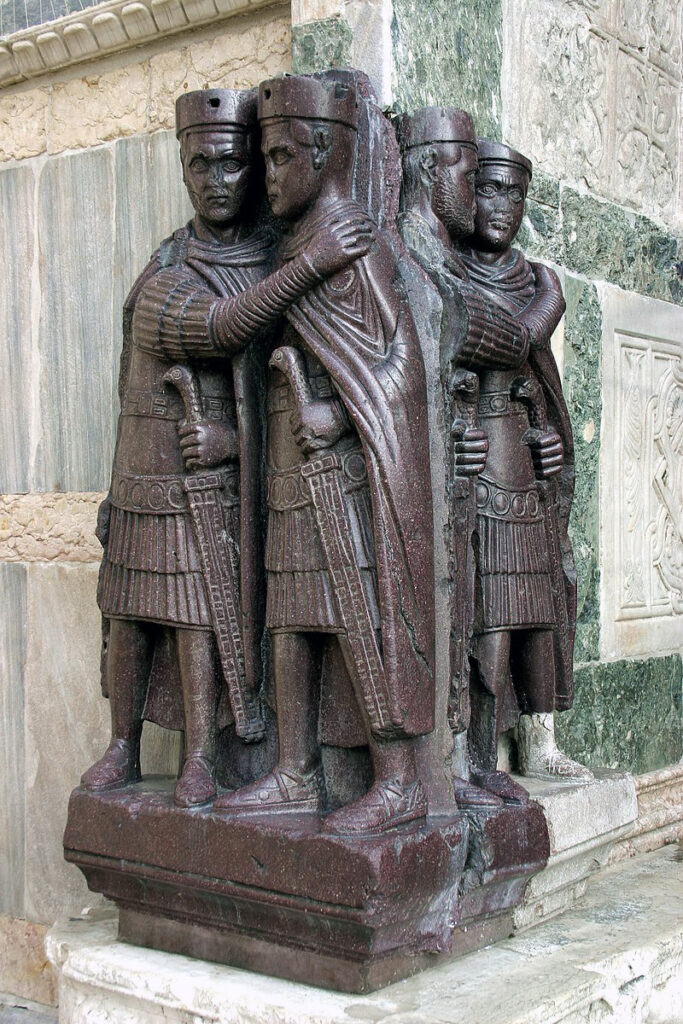
Our next stop takes us to Venice and a very niche artwork. The Portrait of the Four Tetrarchs is a purple porphyry sculpture of four Roman emperors created in 300 CE. Originally located in Constantinople, the capital of the Eastern Roman Empire, the statue was brought to Italy during the 13th century where it now decorates a corner of St. Mark’s Basilica. Located in the exterior of the church in an out-of-the-way corner, these intricately carved statues are packed with history.
“Tetrarchy” comes from the Greek word tetrarchia which means “leadership of four people.” In this case, it refers to the division of the Roman Empire during the 3rd century CE. Instituted by the emperor Diocletian, the Roman Empire was divided into eastern and western territories, with two rulers – known as augusti (senior emperors) and caesars (junior emperors) – presiding over each. The Portrait of the Four Tetrarchs depicts the tetrarchy, the four rulers of the Empire, and exemplifies their unity and authority. This iconic artwork serves as a powerful symbol of stability and order during a period of political upheaval and transition in the Roman Empire.
10. Head of Isis (Cleopatra), Rome

Our final artwork is a Hellenistic bust of a beautiful woman from Ptolemaic Egypt. “Ptolemaic” refers to the period of Greek rule in Egypt established by the Macedonian general Ptolemy I Soter in 305 BCE. It depicts a Ptolemaic princess in the guise of the Egyptian goddess Isis, several scholars believe it to be Cleopatra the Great. The vulture headdress, a crown designated solely for Egyptian goddesses and queens, and a wig of stylized curls arranged in horizontal waves, frame her delicate face.
The 1st century BCE bust is located in Rome’s Centrale Montemartini, a unique museum that was once Rome’s first power plant. The museum opened in 1997 when the Capitoline Museum transferred a selection of its sculptures and artifacts to the new space. The result is an incredible combination of modern industrial machinery and ancient Greek and Roman artwork. The museum offers a vast collection, including ancient sculptures and mosaics, but this small, yet beautiful bust of the famous queen is one of my favorites.


